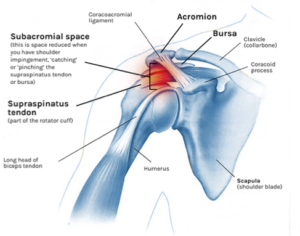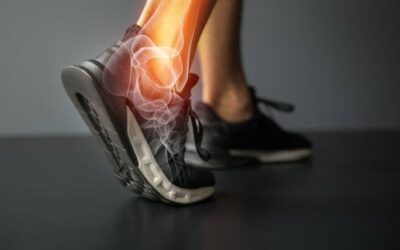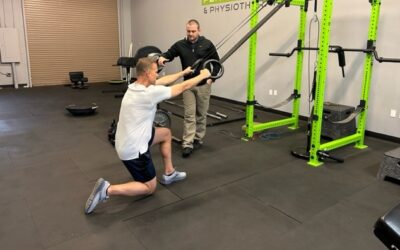The popping, the clicking, the grabbing in the shoulder is a problem.
Well, at least I am sure you feel it is.
When you think of shoulder problems, most people either think of a rotator cuff tear or shoulder impingement.
I have talked before about rotator cuff tears (click here to read about the rotator cuff) so let’s hit on the shoulder impingement.
Whether you went to Dr. Google or your family care physician, do you even know what shoulder impingement is?
A shoulder impingement is basically a broad term to explain a compression of the tissues in the shoulder joint that causes pain.
They have been broken down into 2 categories:
1) External Impingement aka Subacromial Impingement
This is the most common form of ‘impingement’ that is diagnosed. It is when the supraspinatus tendon becomes ‘impinged’ under the acromion process.

The problem with this diagnosis is that it just states what the shoulder does. We already know there is a slight ‘impingement’ that occurs when lifting overhead. THAT IS SUPPOSED TO HAPPEN!
I don’t know when it became a feared thing or why it is used as a diagnosis. It literally just describes what is happening and does not explain pain.
Best Way to Help With Shoulder External Impingement
- You must first realize this does not mean the death of your shoulder. This is literally supposed to happen in your shoulder! Just know, you are not broken and you can overcome this bout of pain.
- Load management. It is important not to push too hard or too fast with this. You want to find a range of motion and resistance level that is not painful for the shoulder and slowly build from there. This is a key time to seek out a skilled physical therapist to help you with that! You don’t want to do too much and piss off the shoulder…You also don’t want to do to little and have very slow effects.
2) Shoulder Internal Impingement
This is more common for the overhead athletes/the throwers
The proposed mechanism of this impingement is the pinching of the shoulder labrum and rotator cuff against the humerus and glenoid rim of scapula. This occurs when the shoulder is externally rotated and abducted.

The problem with just saying all overhead throwers who have pain must have internal impingement is that our bodies adapt! And, they begin to adapt at a very young age.
We have seen little league throwers develop things such as labral tears and partial rotator cuff tears…but in non-painful shoulders!
Not only is that seen in the youth, but major league pitchers were found to have similar findings on imaging, again their shoulders were not painful!
What does that tell us? Our bodies may adapt to what we need to do in life! It might be advantageous for some ‘wearing’ of the shoulder labrum and rotator cuff in overhead throwers to be able to obtain the motion they need to get the velocity they are looking for.
It doesn’t mean that the body is torn and broken.
Best Way to Help Internal Impingement
Since this is mostly in the overhead throwers, we need to look at giving advice to this specific population.
The best preventative measures that can be taken:
- Don’t specialize in a sport early on in life. Variability of movement is good instead of doing the same thing year-round. Do you think MLB pitchers pitch year-round? They take time to recover because they realize the importance of not fatiguing the shoulder.
- Monitor your training load. This includes the volume of your workouts and intensity. Please use a professional to help you with this.
- Strength training: train your body to be strong in those ranges of motions/demands so it is ready to perform. Again, it is imperative to work with someone who can break down the demands of your sport and make a specific program that will suit you.
Summary
It was mentioned in prior articles, but imaging does not tell you about pain. Pain is something you feel, not see. Just because the physician sees something on the image does not mean that it is the thing causing the pain.
A study was performed that included 6112 shoulders and the presence of an ‘abnormality’ was 9.7% in 20 year olds and increased to 62% in 80 year olds. (ref: A systematic review and pooled analysis of the prevalence of rotator cuff disease with increasing age).
Stats are fun, but what that really means, and was the conclusion of the study: The prevalence of rotator cuff abnormalities in asymptomatic people is high enough for degeneration of the rotator cuff to be considered a common aspect of normal human aging and to make it difficult to determine when an abnormality is new (e.g., after a dislocation) or is the cause of symptoms.
What To Do Next
First, you need to scratch the narrative that an exercise must be bad for you. Long ago people believed that shrugging your shoulder would cause more impingement or lifting your arm upright with your thumb pointing down will pinch the rotator cuff…
As it turns out, that is not the truth.
The only dangerous movement you perform is the one you are not ready for.
Second, feel free to reach out to us with any questions! Email us at [email protected]
We truly believe there is a better way than always opting for surgery, taking some pain meds and giving it time, or rubbing some pain-relieving cream on it. You are an active adult or athlete, down time is not an option.
We would love to help get you over your shoulder pain and back to throwing the ‘wheels’ over your head, throwing the ball to your kid, or just driving more comfortably.




